|
TEST
GEAR AT G3PHO 2005
|
|
Since the earlier pages describing my test gear were compiled some years ago, there have been considerable changes, particularly during 2004-2005. I was fortunate to acquire a number of items of test gear for free! These included an HP141 spectrum analyser, a Wiltron 18GHz sweeper and an HP436 power meter. In addition I was also able to buy other items at very cheap prices... 2004-5 must go down as by luckiest years in microwaves! The photo on the right was taken in early 2004, before some of the equipment mentioned above was obtained. It's here in my radio shack where I make most of my microwave equipment. It's very handy to have microwave power meters, a couple of spectrum analysers and other test equipment within an arm's reach of any gear being constructed. |
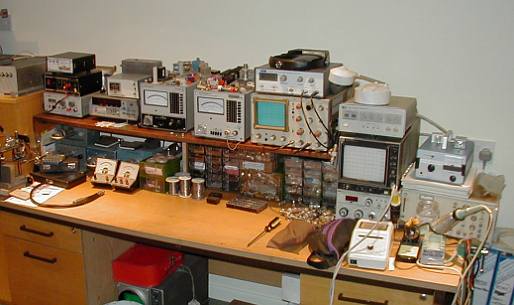 |
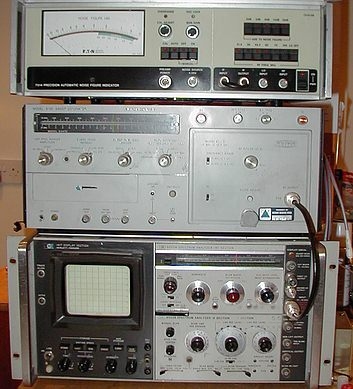 |
In August 2004 I was made the amazing offer of a large amount of free test gear.This was all to have been thrown away as waste if I hadn't taken it! Included in the offer were three HP141 18GHz spectrum analysers, four HP 18GHz sweepers, a Wiltron 610D sweeper, four HP microwave power meters (HP435/436 types) and sundry other items including a spare RF and IF plug in for the HP141. I made the 320 mile trip down South to get this gear feeling extremely fortunate! As a result I've been able to give two of my local microwave friends each a spectrum analyser, HP power meter and a sweeper.It seemed as if all their Christmasses had come at once! Another friend got an HP436 power meter! Pictured left is the centre bench of my test gear station, with from top to bottom: Ailtech 7514 Noise Figure Indicator (PANFI), Wiltron 610D 10MHz-18GHz sweeper, HP141T+ RF plug in for 0-18GHz spectrum analysis.In addition I have the 0-110MHz RF plug in for the HP141T as well as an HP mixer to allow me to "see" both 24GHz and 47GHz on the analyser. The Ailtech Noise Figure Indicator has selectable IF inputs and the facility to inject an external Local Oscillator to create almost any IF you want. I also have a 12GHz Ailtech Noise Head for this gear and it seems to have a reasonably constant ENR across a wide range from at least 1GHz to over 12GHz. |
|
Shown on the right is another "rack" of test gear recently acquired... From centre top to bottom: Farnell FG3 Function Generator, HP436 Power Meter with matching RF head to 18GHz at 10 microwatts (to 10mW with matching 30dB inline attenuator), Racal Dana 9916 frequency counter with homemade prescaler to approx 3GHz. To the left of the central rack can be seen, from top to bottom, some items I've had for several years.... "Poor Man's Caesium Clock" 1MHz/10MHz TV locked frequency standard, G4COM simple noise figure meter, 12V 10A DC bench power supply and a Marconi 12GHz variable oscillator source. On the far right is the edge of one of my two Marconi Microwave power meters for which I have RF heads up to 26GHz. |
 |
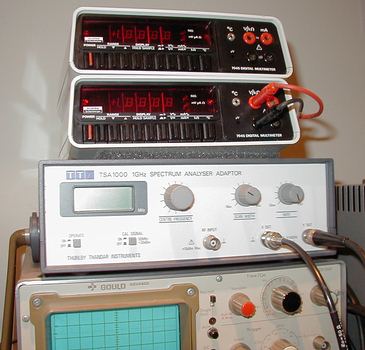 |
Shown left are, from top to bottom, a couple of bench digital multimeters which I bought at an amateur fleamarket in early 2005 for just £5 ($8 US) for the two! Below the DVMs is my Thander 0-1GHz Spectrum Analyzer Adapter which I purchased many years ago at a price that I could now buy a surplus HP141T system for today! It has given me good service even though it's range is limited. They appear on Ebay from time to time at around £100 and are a cost effective way of getting a spectrum analyser for the lower microwave region. With external mixers it's possible to look at frequencies much higher of course. The adapter is connected to the X and Y inputs of a Gould oscilloscope. The scope bandwidth can be as low as 10MHz in this application. Suitable scopes can be bought at fleamarkets for as little as £20 |
|
One corner of my shack houses the frequency measuring and generating equipment.The lower left side of this photo is my main frequency reference which outputs a series of extremely accurate sources at 1MHz, 5MHz and 10MHz, in addition to 100kHz and 10kHz. Several of these outputs are used to lock either of the two Adret 5105 synthesizers (the identical units standing on top of the Racal synthesizer in the lower right region of the photo) as well as the Racal and my frequency counter. This frequency reference has been running continuously for over 5 years. From time to time I check it against a TV locked source but it never seems to vary in accuracy. Other sources shown here include an old Polarad 6-11GHz signal generator, still quite useful at times, a Pye HS4B 48MHz source, a Qualcom 1152Mhz source and a home made 96MHz source locked to the 60kHz MSF transmissions. |
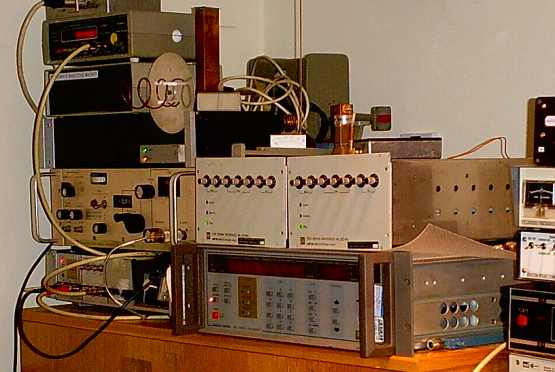 |
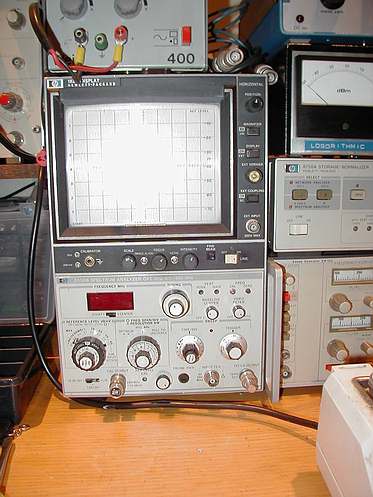 |
Shown left is my 1.5GHz spectrum analyser, the HP 182T/HP8555B.This instrument is quite portable and I have taken it up to my local amateur radio club for a demonstration. To the left of it are, from top to bottom, is a homemade sun noise meter (designed by G4NNS), a logarithmic amplifier, a HP Normaliser (used with the spectrum analyser to store traces for reference against others in real time, and at the bottom, a Gould 2GHz sweeper. The item on top of the analyser is a 0-30V variable DC bench power supply. |
 |
To the left is one of my two Marconi 6460/3 Microwaver Power meters with a 100mW 12GHz head attached. These have been available on the UK surplus market in reasonably large quantities over the past few years but the supply of spare RF heads is getting smaller and smaller. They are easily damaged by overload or shock from dropping them. Today the heads alone cost more on the surplus market than the complete power meter and head did say 10 years ago! Notice the array of coax to waveguide transitions on the top of this power meter. I have them up to 24GHz or so, along with a good selection of directional couplers in both waveguide and coax. I also have a number of isolators, in waveguide and also coaxial types. These are most useful when measuring higher RF powerlevels than the power meter can handle.Of course I also have msny coaxial attenuators, several good to 26GHz and some relatively high power ones (25 to 50 watts) up to 12GHz. You can never have too many attenuators! |
| There are many other items of test gear in my shack(much of it home made), including an audio oscillator, VHF and microwave wavemeters, RF "sniffer, and so on ... the kind of items than any self-respecting radio amateur should have available for testing his equipment. Much of it is simple stuff that does a good job. You don't need to spend a fortune to get reasonably well equipped to tackle most fault tracing and equipment evaluation and alignment. Regular browsing of Ebay is an essential if you want to get some decent test gear! Some items can be obtained very cheaply, such as the nice little clone of a Leader signal generator shown right...it was only £15 at a "fleamarket" and is in pristine condition. |
 |
| Having never been in the radio or electronics industry (I was a High School Geography teacher for 36 years!) and therefore completely cut off from some excellent test equipment that I know my friends "in the business" can access, I feel fortunate that I am now reasonably well-equipped to make most of the tests and measurements I need for my microwave hobby. |
Be careful ... Testing and test gear can become an obsessive hobby in its own right!I know folk who obtain test equipment to test other test equipment! |
|
|
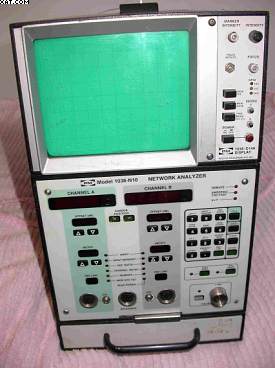 On
the right is my Pacific Microwave network analyser which
I hope to get going quite soon. It has a couple of faulty switches
and I am short of some connectors for it.Once again, I was fortunate
enough to have been given this useful instrument!
On
the right is my Pacific Microwave network analyser which
I hope to get going quite soon. It has a couple of faulty switches
and I am short of some connectors for it.Once again, I was fortunate
enough to have been given this useful instrument!